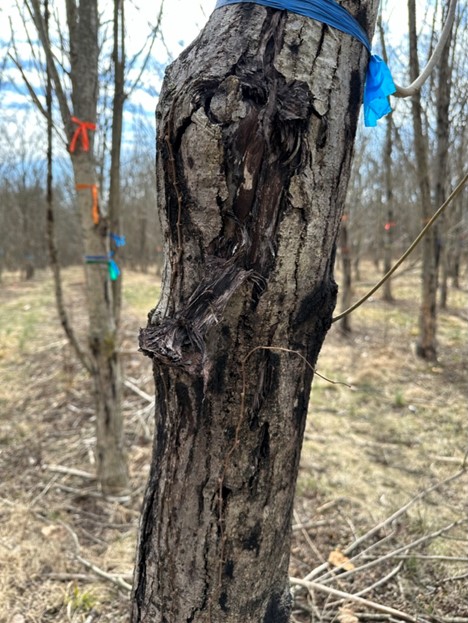Integrating morphology, genotype, and chemotype based methods to support butternut conservation and resistance breeding efforts
Integrating morphology, genotype, and chemotype based methods to support butternut conservation and resistance breeding efforts
 Resistance to pest and disease threats may be obtained by hybridization between native species and their relatives. Butternut (Juglans cinerea L.) is a native hardwood tree species threatened by butternut canker disease (BCD). Hybrids between butternut and J. ailantifolia have resistance to BCD and form a key component of BCD resistance breeding programs, yet are difficult to distinguish from pure butternuts. In this project, we will integrate across three methods (morphology, genotype, and chemotype) to determine the pedigree of ~1,500 trees of interest in HTIRC’s BCD resistance breeding program (Objective 1). We will distinguish among butternut, J. ailantifolia, and their hybrids including % hybridity (i.e., F1, F2 hybrid, BC1), and confirm chloroplast identity. We will then determine the relative accuracy of these three methods (Objective 2). Additionally, we will assess incidence and severity of BCD and bunch disease among genotypes (Objective 3), and the potential for spectral-based (chemotype) data to detect disease incidence and severity (Objective 4). Combined, these three approaches will allow us to fully characterize the pedigree and disease resistance of the germplasm in the HTIRC butternut breeding program. This will enable us to detect unique sources of genetic diversity for conservation, to select the most butternut-like disease resistant hybrids, to prioritize candidate trees for disease resistance screening, and to identify optimal germplasm for both pure butternut and hybrid seed orchards to support restoration in planted and natural forests. Project results will be disseminated via field days, Extension publications, and web resources. This project will provide the first known comparison among morphology, genotype, and chemotype methods in determining hybridity in naturally hybridizing populations of a forest tree species. An approach that integrates phenotypes using advances in genetics and digital forestry should be a powerful tool for butternut resistance breeding and also provide scalable, relevant methods for other species.
Resistance to pest and disease threats may be obtained by hybridization between native species and their relatives. Butternut (Juglans cinerea L.) is a native hardwood tree species threatened by butternut canker disease (BCD). Hybrids between butternut and J. ailantifolia have resistance to BCD and form a key component of BCD resistance breeding programs, yet are difficult to distinguish from pure butternuts. In this project, we will integrate across three methods (morphology, genotype, and chemotype) to determine the pedigree of ~1,500 trees of interest in HTIRC’s BCD resistance breeding program (Objective 1). We will distinguish among butternut, J. ailantifolia, and their hybrids including % hybridity (i.e., F1, F2 hybrid, BC1), and confirm chloroplast identity. We will then determine the relative accuracy of these three methods (Objective 2). Additionally, we will assess incidence and severity of BCD and bunch disease among genotypes (Objective 3), and the potential for spectral-based (chemotype) data to detect disease incidence and severity (Objective 4). Combined, these three approaches will allow us to fully characterize the pedigree and disease resistance of the germplasm in the HTIRC butternut breeding program. This will enable us to detect unique sources of genetic diversity for conservation, to select the most butternut-like disease resistant hybrids, to prioritize candidate trees for disease resistance screening, and to identify optimal germplasm for both pure butternut and hybrid seed orchards to support restoration in planted and natural forests. Project results will be disseminated via field days, Extension publications, and web resources. This project will provide the first known comparison among morphology, genotype, and chemotype methods in determining hybridity in naturally hybridizing populations of a forest tree species. An approach that integrates phenotypes using advances in genetics and digital forestry should be a powerful tool for butternut resistance breeding and also provide scalable, relevant methods for other species.
(Funding: USDA NIFA, USDA Forest Service, HTIRC)
